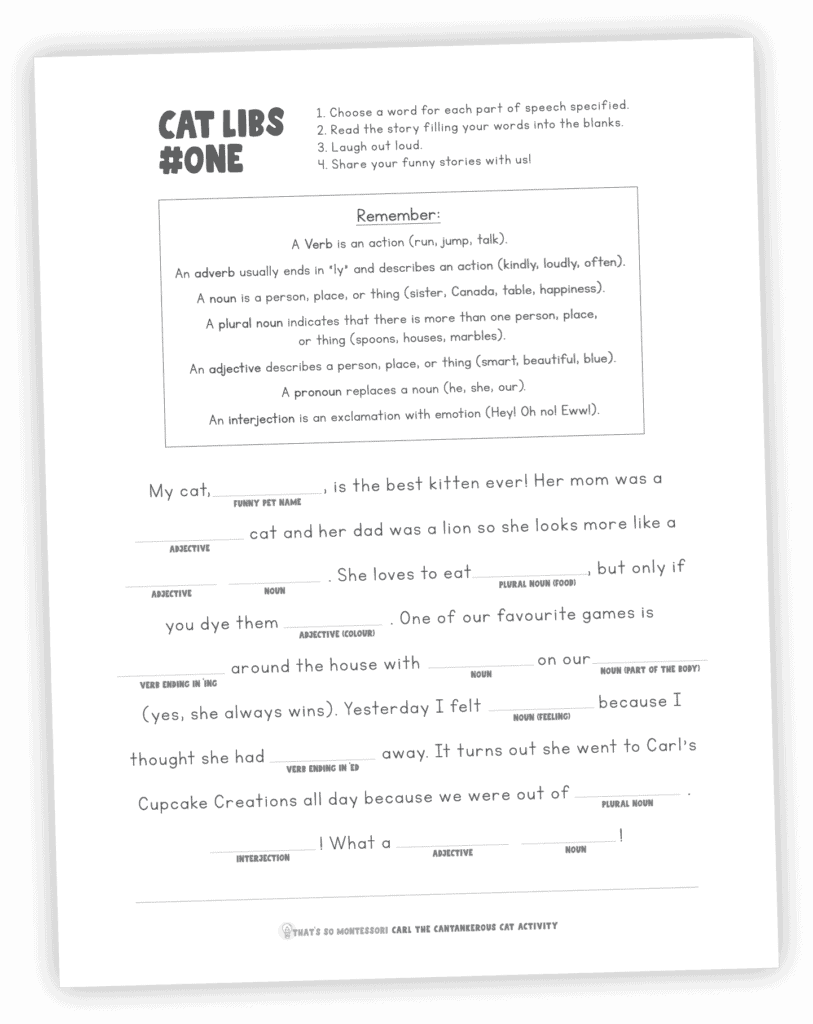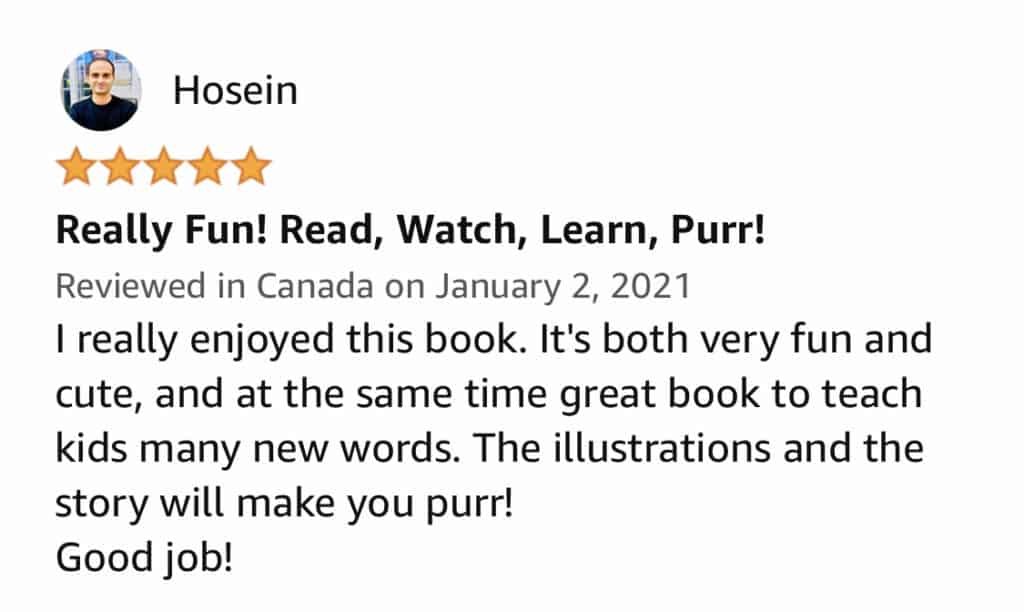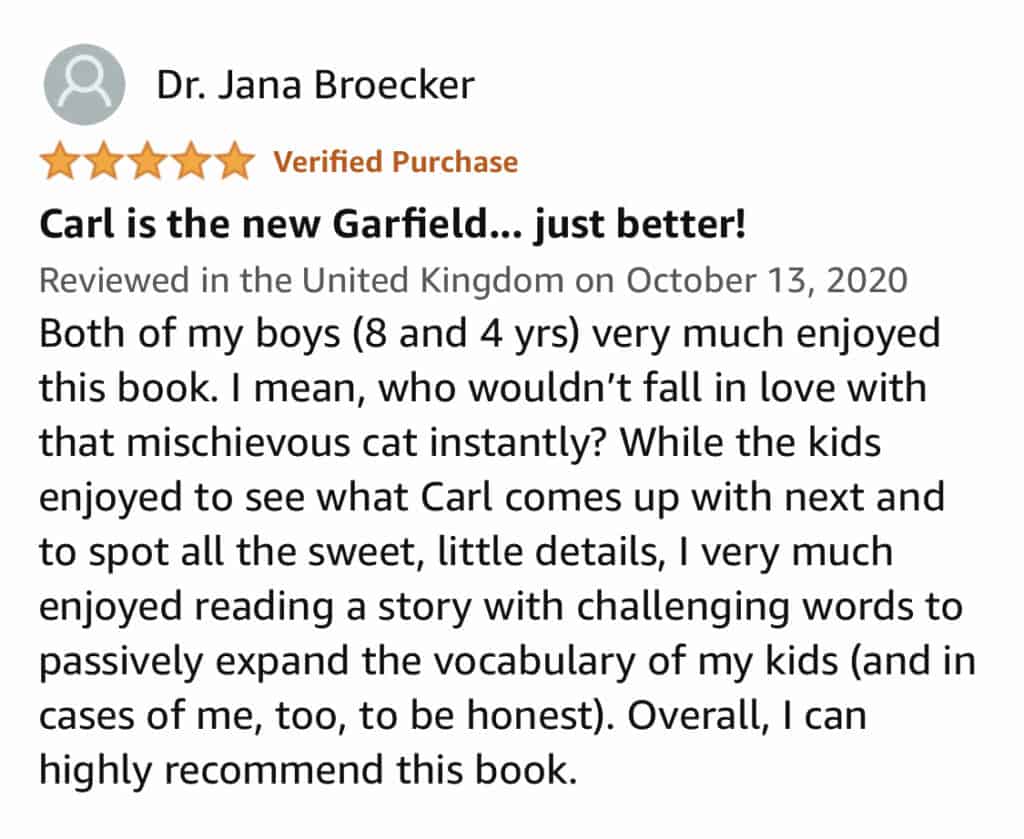This is One of the Best Picture Books to Teach Vocabulary And I’ll Tell You Why
This is undoubtedly one of the best picture books to teach vocabulary, and I’m excited to reveal why it’s such a game-changer for elementary students!
As a Montessori elementary teacher, step-mom, and children’s picture book author, I understand the importance of using engaging books for language acquisition.
That’s why I’m thrilled to share with you our self-published picture book for vocabulary enrichment. Whether you’re an educator, caregiver, or parent, this book is essential for fostering vocabulary growth in elementary-aged children.
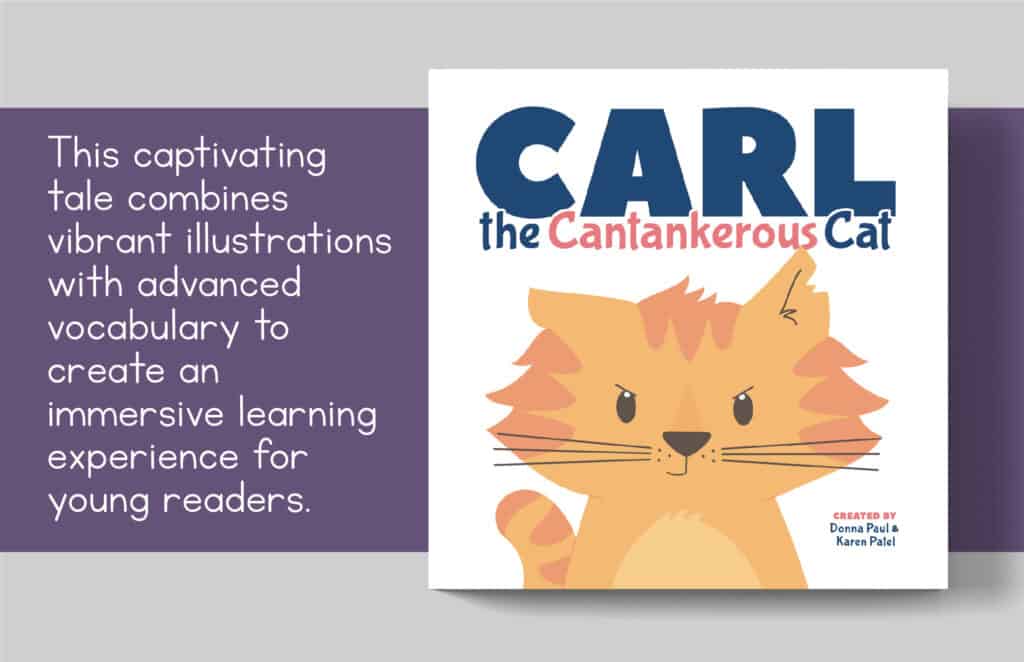
Introducing Carl the Cantankerous Cat, a picture book which I genuinely believe is among the finest when it comes to teaching vocabulary.
This captivating tale combines vibrant illustrations with advanced vocabulary to create an immersive learning experience for young readers.
But this article isn’t just about Carl – it’s about unlocking the potential of picture books to enrich vocabulary in your elementary classroom. You’ll learn about key features to look for when in search of picture books that expand vocabulary for elementary students.
So while Carl is an excellent choice, there are many other picture books that excel in building a rich vocabulary.
To ensure you have a variety of options, I’m including a short list of other fantastic picture books at the end of the article. These selections are handpicked to provide diverse and engaging ways to improve vocabulary in elementary students.
Join me as we explore the world of picture books and uncover the keys to finding ones that enhance vocabulary at the elementary level!
Five Reasons Why Carl the Cantankerous Cat is One of the Best Picture Books to Teach Vocabulary
I believe a vocabulary-teaching picture book should not only introduce diverse words but also seamlessly weave them into a captivating story with a moral lesson for kids.
Our self-published children’s book accomplishes this, establishing itself as a top choice for enhancing vocabulary.
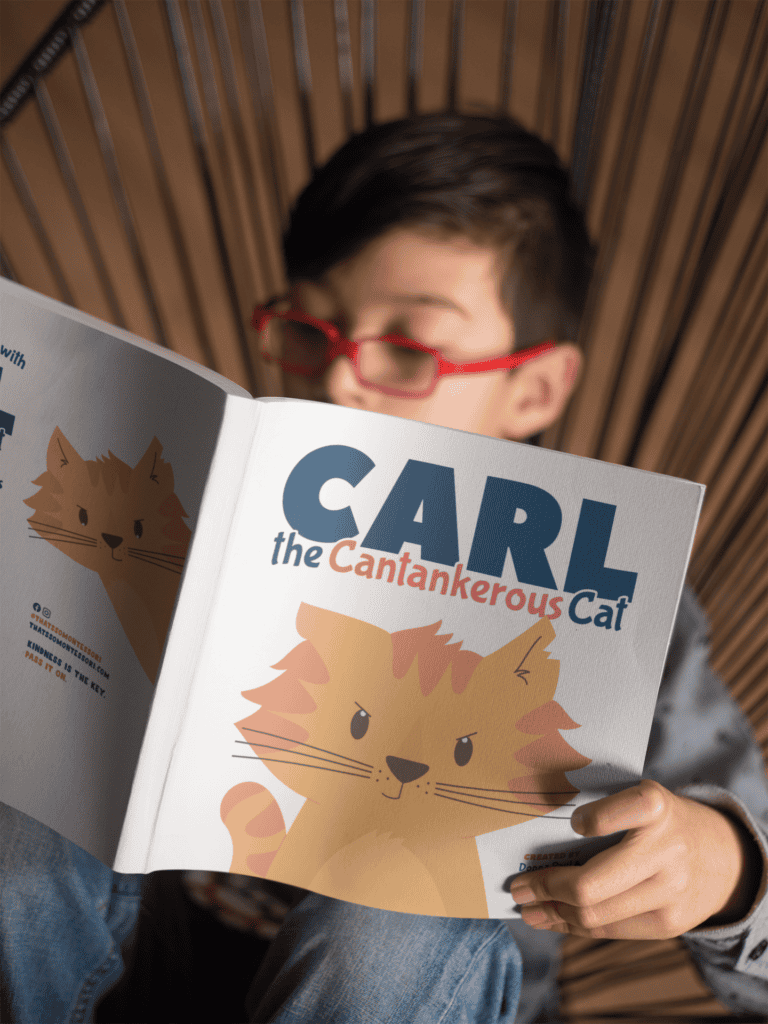
Here’s a brief overview of why Carl the Cantankerous Cat is such a standout choice. Keep reading for a more comprehensive breakdown of this criteria I look for when choosing picture books that teach vocabulary.
1. Advanced vocabulary words are included.
This story is over 30 pages and packed with eye-catching visuals as well as an abundance of advanced words. That’s right, Carl the Cantankerous Cat is more than just a picture book – it’s a fun teaching tool that fosters learning in disguise.
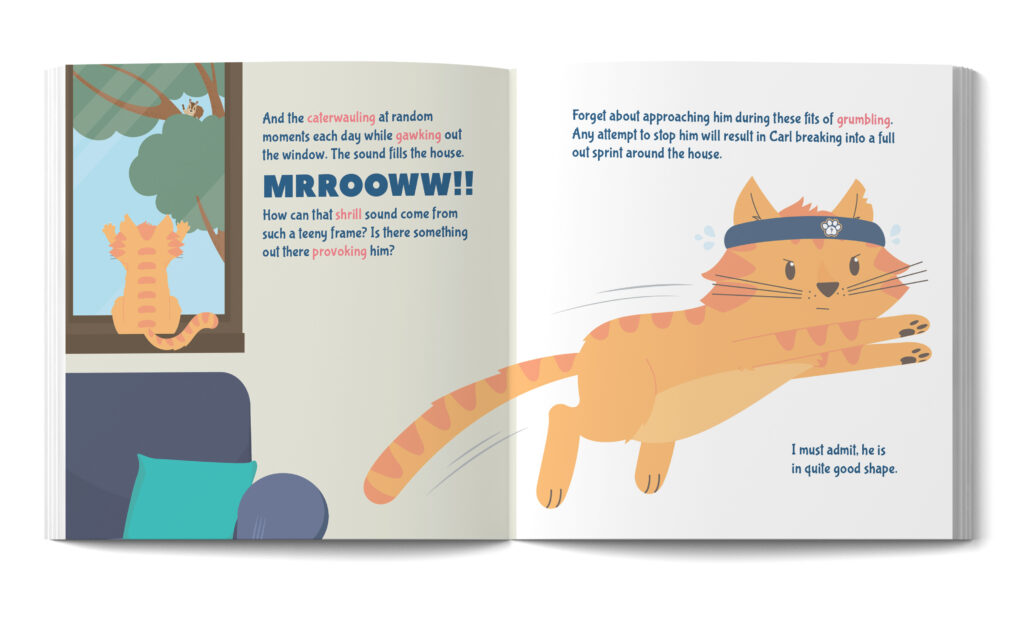
As depicted in the spread above, each page showcases at least one highlighted word – five in this instance! – uncommon to elementary-aged children, expanding their vocabulary.
Furthermore, to facilitate learning, all highlighted words are listed in an alphabetical glossary at the back of the book, ensuring children can easily grasp the meaning of these words as they read. We’ll get into this in more detail shortly.
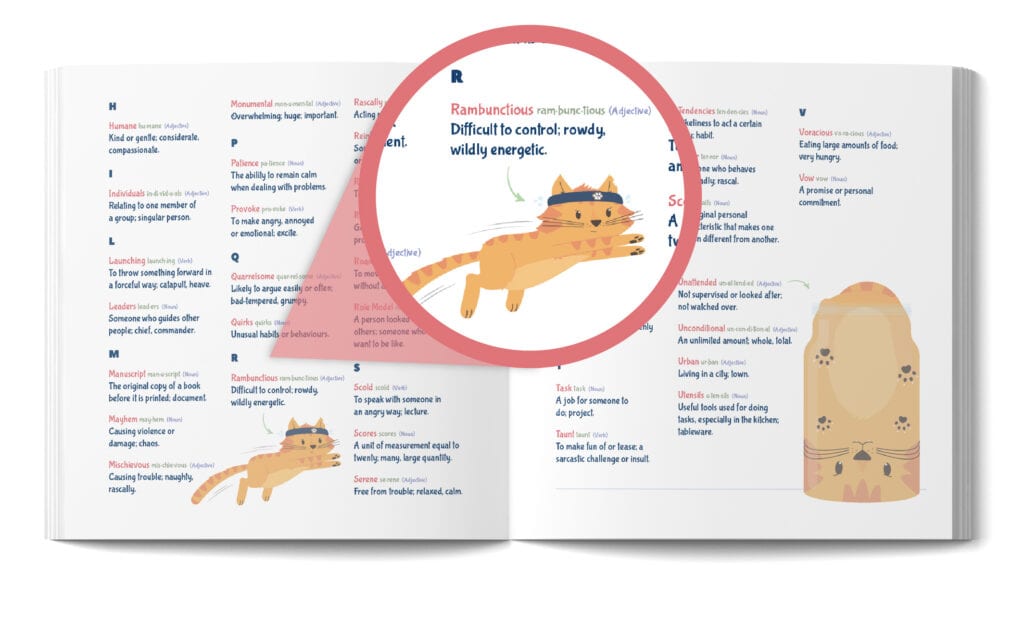
2. The illustrations bring the words to life on every page.
Kids love picture books because the visuals stimulate their imagination and help them understand the story better.
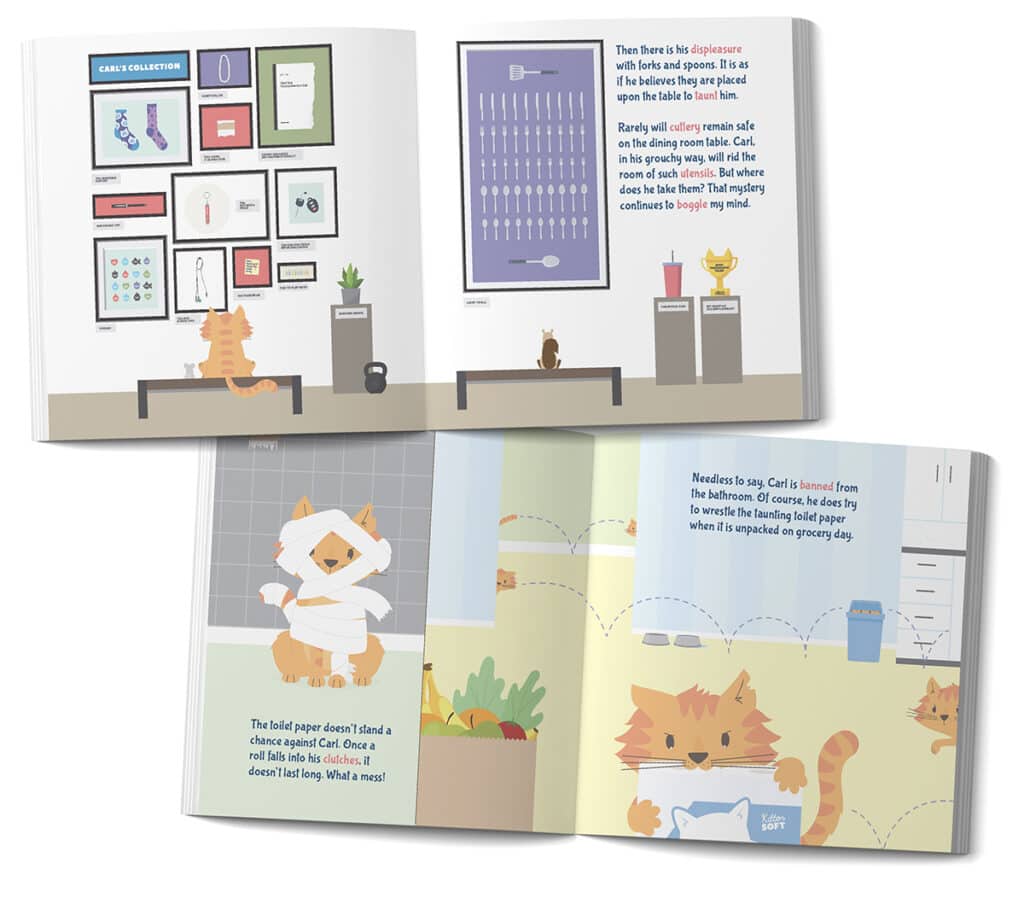
Pictures add depth to the narrative, making characters and settings come alive in vibrant colours and captivating illustrations. The combination of words and images creates a multi-sensory experience that engages children and encourages them to explore the story in their own unique way, sparking curiosity and fostering a love for reading from an early age.

The illustrations in Carl the Cantankerous Cat were created purposefully and act as guides, assisting readers in grasping the story and providing context for unfamiliar words. Through their detailed depictions, they vividly portray events, helping readers in following along and understanding the narrative.
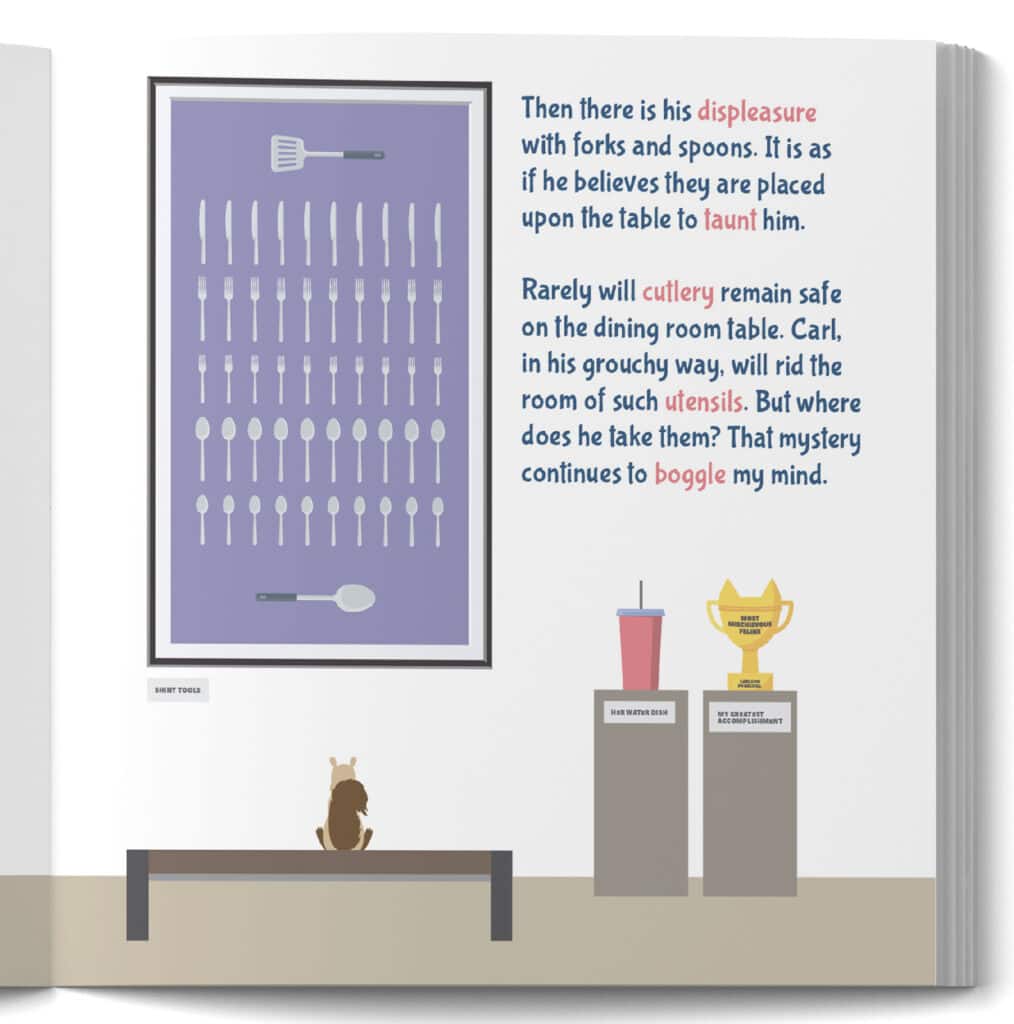
3. There’s a glossary included that defines highlighted words.
If the captivating spreads themselves aren’t enough to help understand these new words, don’t worry! You’ll find a glossary of new terms at the back of the book, providing definitions that enhance the reading experience.
Here’s an example one of the two glossary spreads:
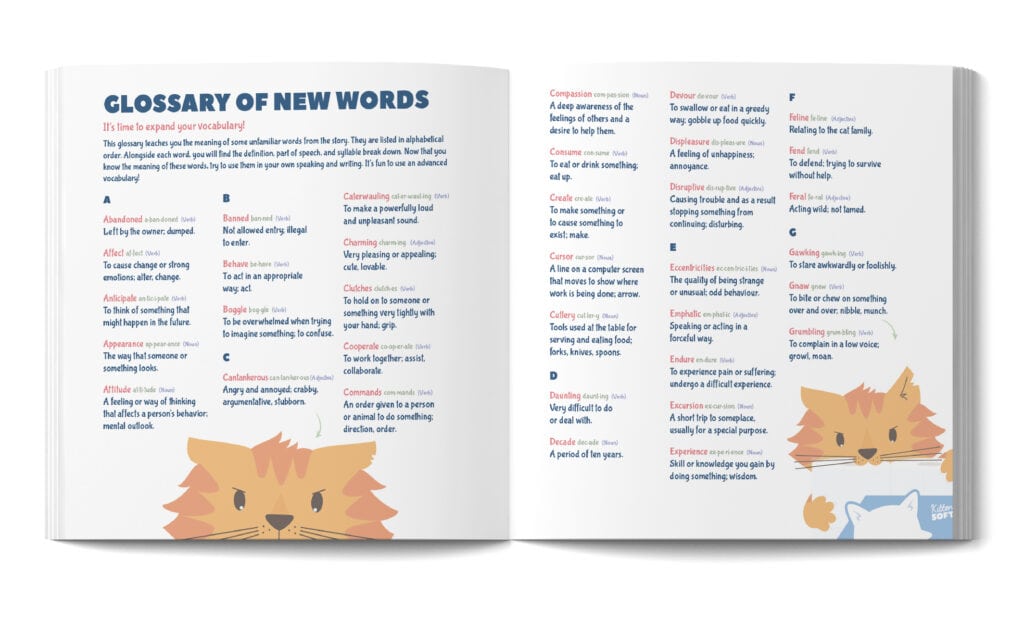
As mentioned previously, on each page, highlighted words stand out in the story, serving as cues for readers. These same words are then defined in the glossary at the back of the book, ensuring easy access to their meanings for enhanced comprehension.
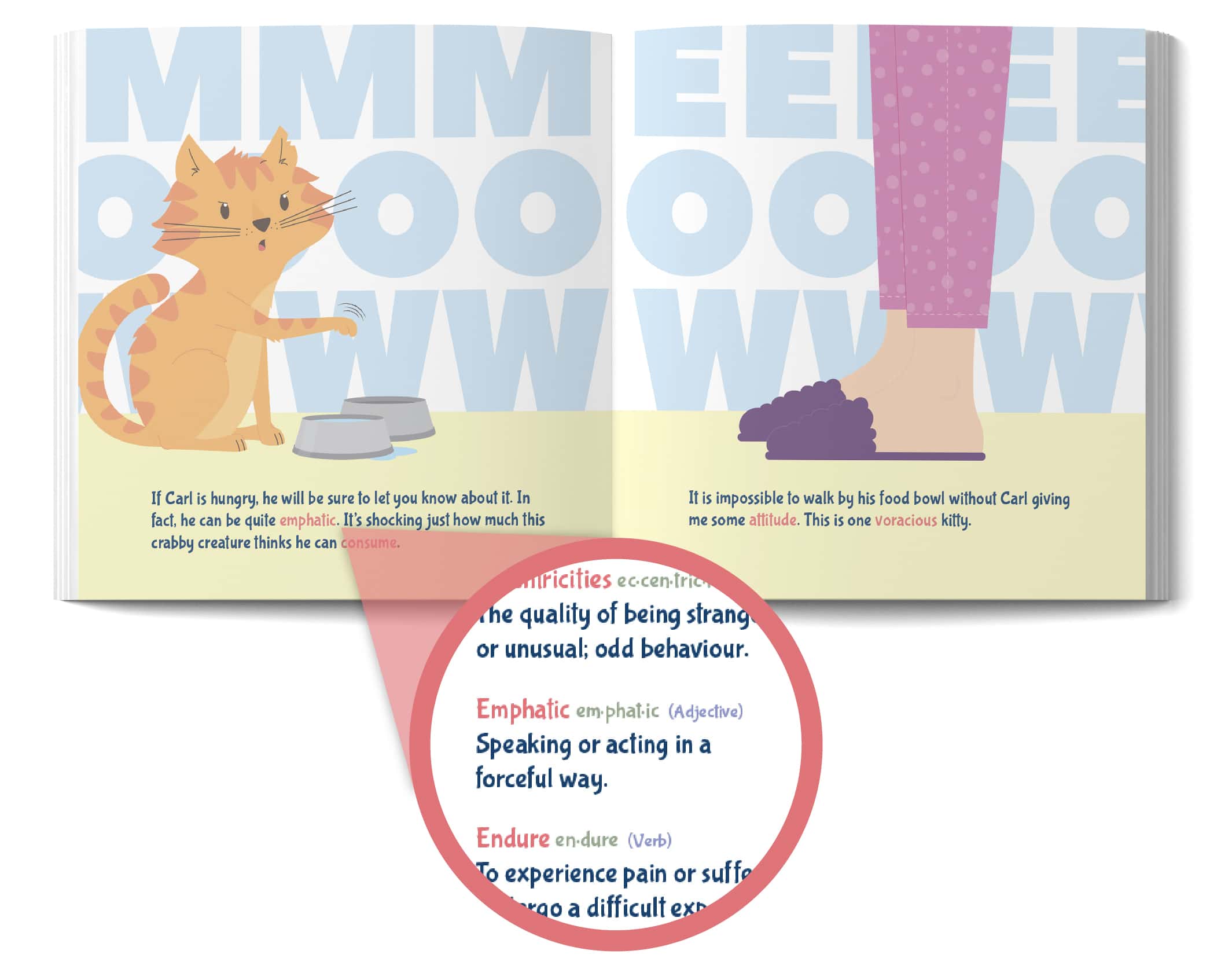
This aligns with the Montessori learning approach, which emphasizes independent learning and self-correction. By having word meanings readily available, students can engage in self-directed exploration and enhance their understanding at their own pace.
4. It’s an engaging story filled with teachable moments.
Carl the Cantankerous Cat also offers many teachable moments for children.
With its relatable characters and engaging storyline, kids are drawn into Carl’s journey of learning to be loved despite his crabby nature.
A picture book with teachable moments fosters cognitive development by engaging young readers with valuable lessons in an accessible format, promoting critical thinking and empathy from an early age.
Integrating teachable moments enhances the book’s educational value, enriching the reader’s experience and facilitating meaningful discussions between children and caregivers.
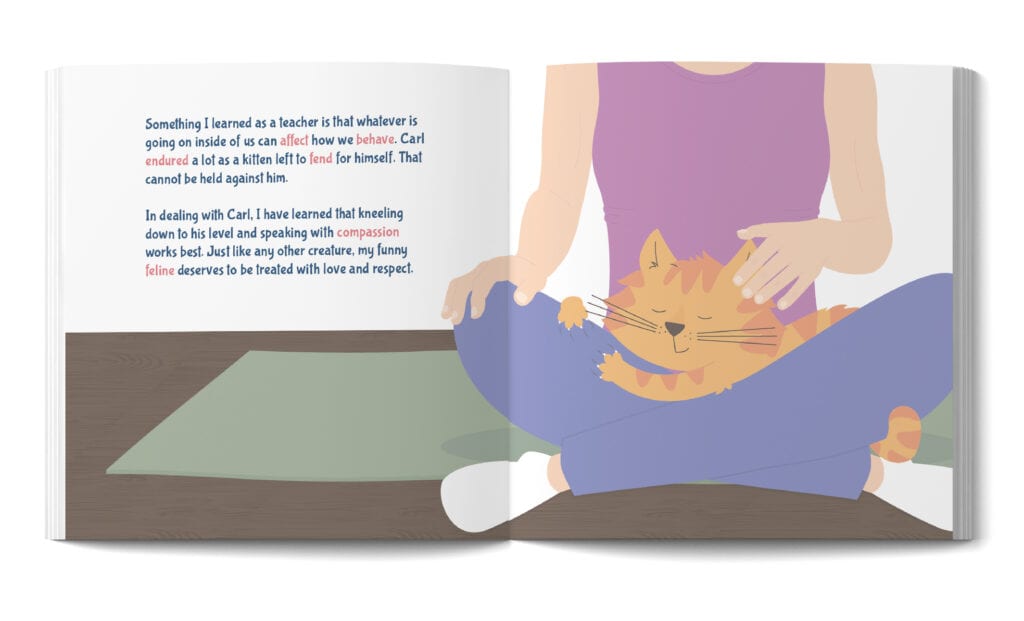
Through Carl’s experiences, children learn about empathy, resilience, and the importance of acceptance, all while engaging in learning in disguise.
5. Exciting follow-up activities await.
To extend the learning journey even more, there’s a full spread of follow-up activities for children to explore after reading the book.
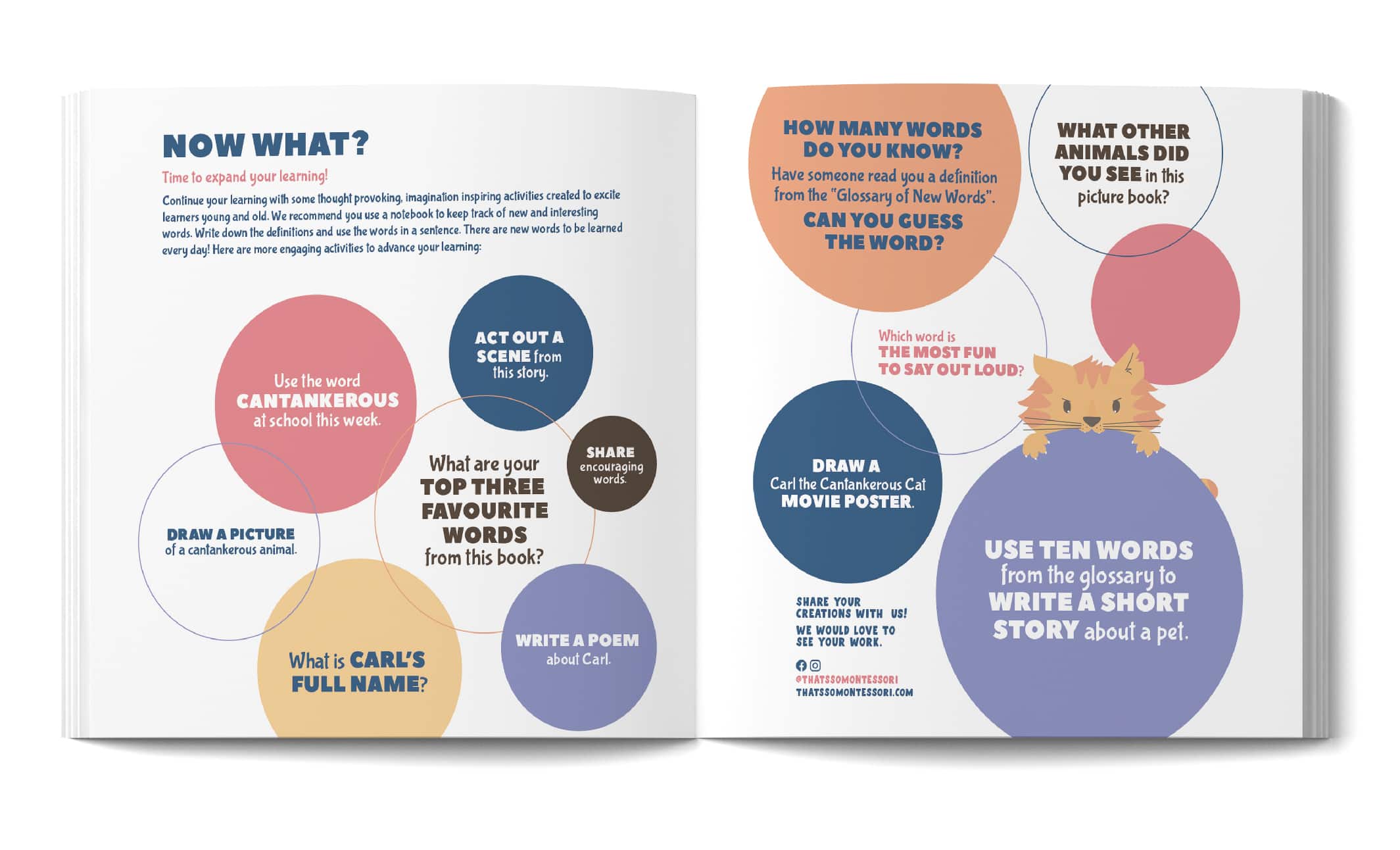
Follow-up activities in a picture book deepen comprehension, reinforce learning, and encourage active engagement, transforming passive reading into an interactive learning experience that extends beyond the pages. These activities promote creativity, problem-solving, and social skills, enhancing the overall educational impact of the book.
Given the reasons mentioned, I firmly believe that Carl the Cantankerous Cat stands out as one of the best picture books for teaching vocabulary.
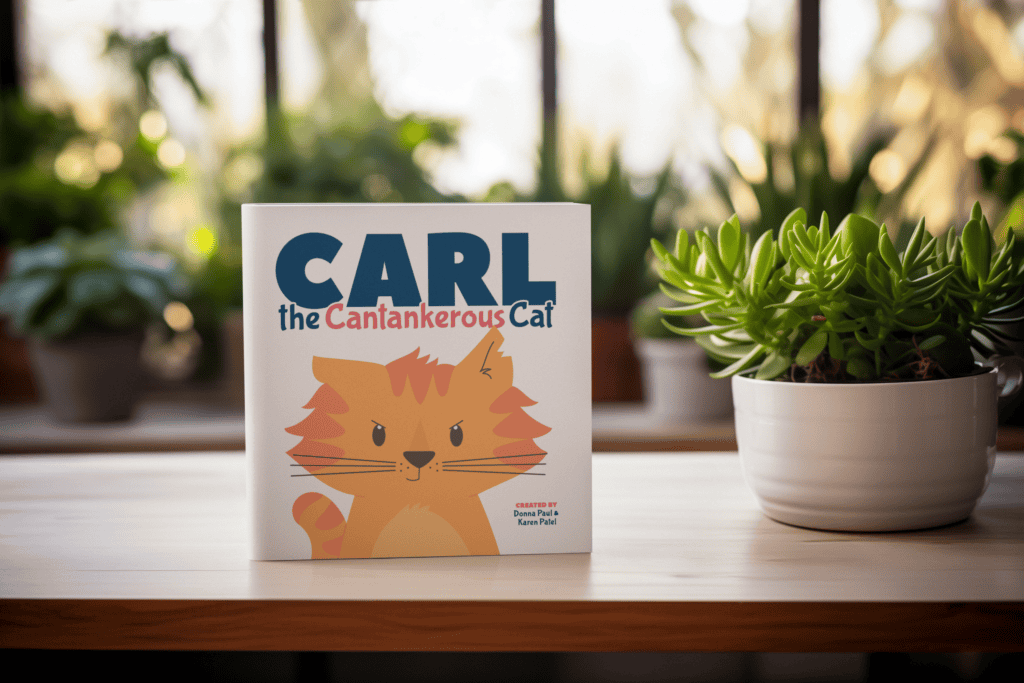
When writing this book, I meticulously ensured it met specific criteria. Keep reading to discover the key elements I consider crucial in picture books for vocabulary instruction.
💡Teacher Tip: Click here to explore our curated collection of articles on language, books, and learning!
My Suggestions for Finding Picture Books That Teach Vocabulary
I believe finding picture books for teaching vocabulary is easy if you keep a few important criteria in mind.
By carefully considering the flow of the story, the complexity of the language, and the visual appeal, educators, parents, and caregivers can choose picture books that engage elementary learners.
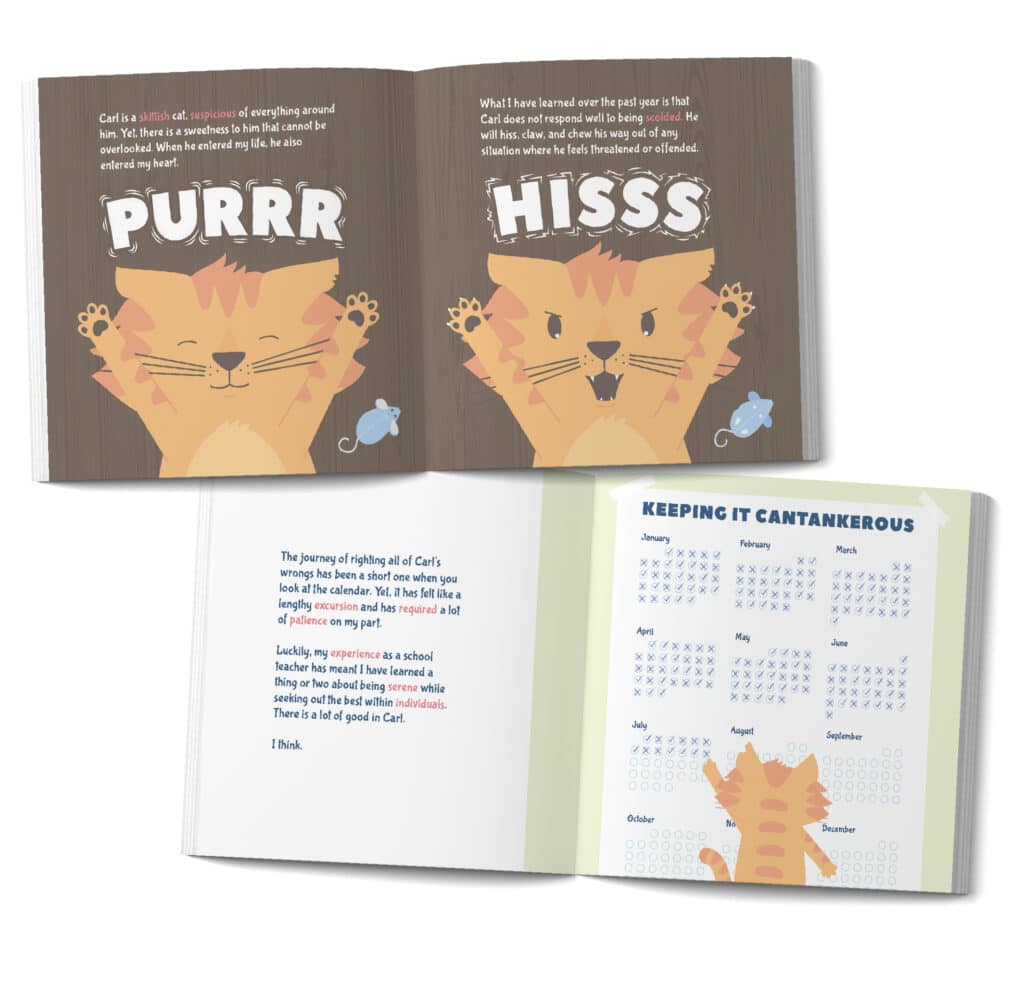
Criteria I Use When Looking for Picture Books to Teach Vocabulary
Here’s an overview of the criteria I consider when selecting picture books that effectively teach vocabulary.
This is also the check list that I kept in mind during the process of writing and illustrating Carl the Cantankerous Cat.
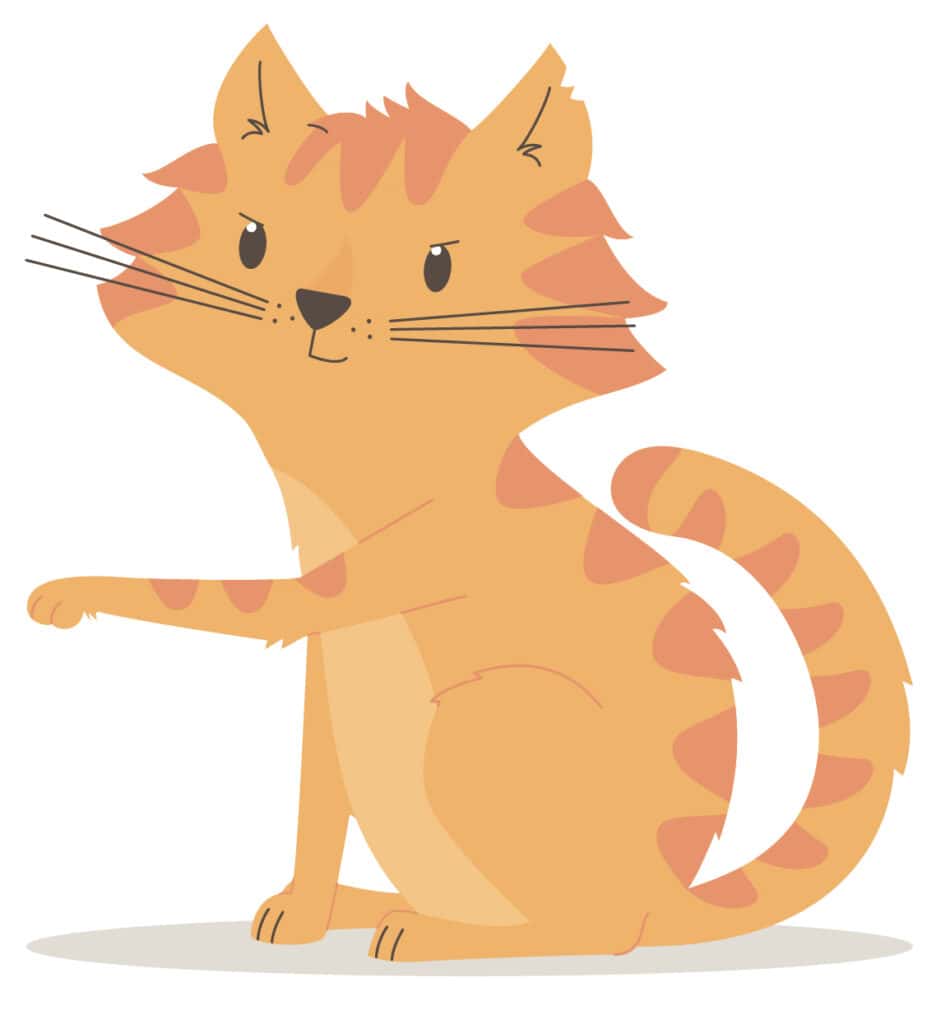
Using picture books that meet these standards will significantly enhance children’s vocabulary skills.
These qualities not only align with Montessori principles but also ensure that children have access to high-quality literature, promoting language development and fostering a love for reading.
💡 Teacher Tip: Carl is a PURRfect addition to your family book club!
Interested in starting a family book club but unsure how to begin? Don’t worry – we’ve got you covered!
Check out our blog How to Start A Family Book Club Now for helpful tips and tricks.
Here’s How Carl the Cantankerous Cat Meets the Criteria of Being a Vocabulary-Boosting Book
This picture book for kids embodies the qualities I look for in vocabulary-teaching picture books – mainly because I created it specifically for elementary children!
Let’s go through this checklist and see how Carl the Cantankerous Cat meets my criteria for finding vocabulary-enriching children’s picture books.
Incorporates Difficult Words Naturally into the Story
Word choice is the secret sauce in the recipe for effective vocabulary teaching.
The right words not only expand a child’s vocabulary but also foster a love for language exploration, setting the stage for a lifelong journey of word discovery.
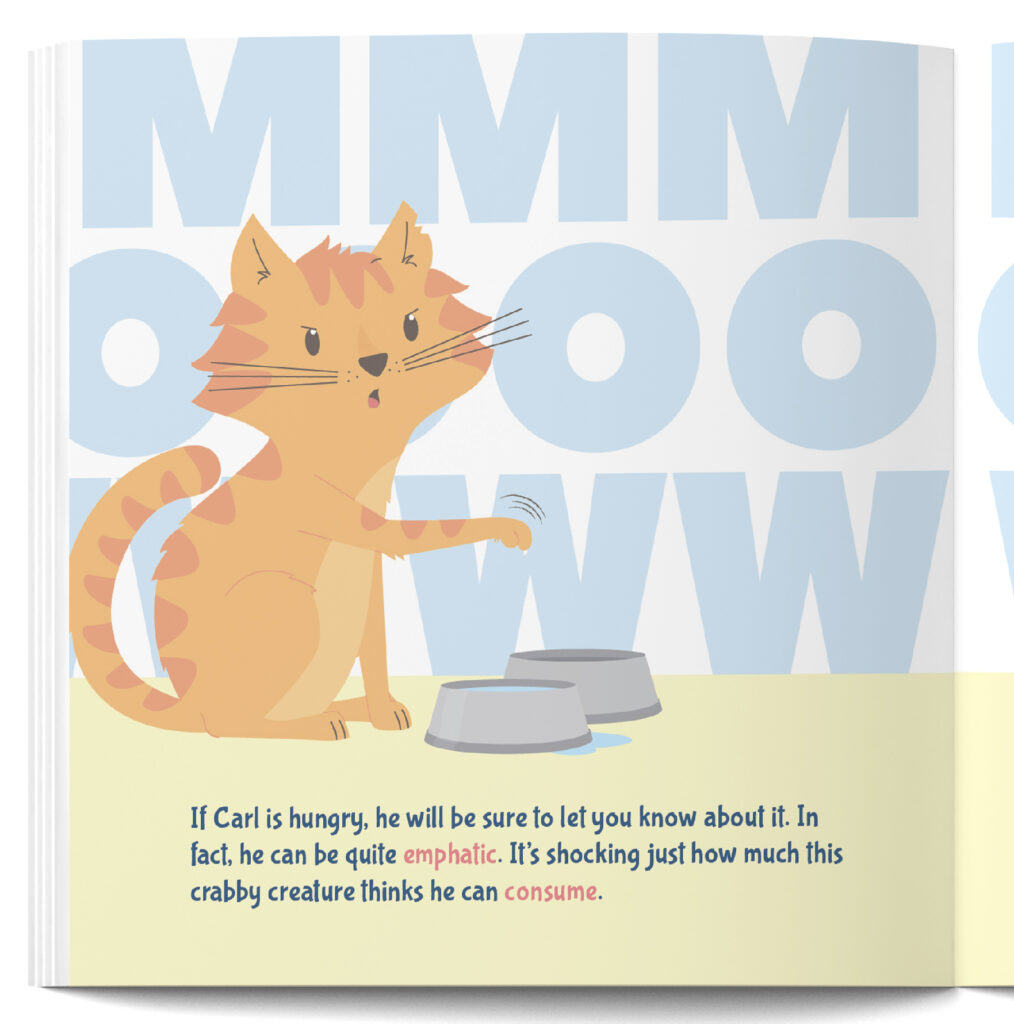
A great vocabulary-teaching book stands out by including diverse words in an engaging story, keeping kids more interested and open to understanding and remembering the words they’re learning.
Our book is one of the best picture books to teach vocabulary because it uses advanced words.
In Carl the Cantankerous Cat, kids are faced with new and tricky words but they blend seamlessly into the story. And with a handy glossary at the end, understanding these words becomes even more fun, making learning fun from start to finish.
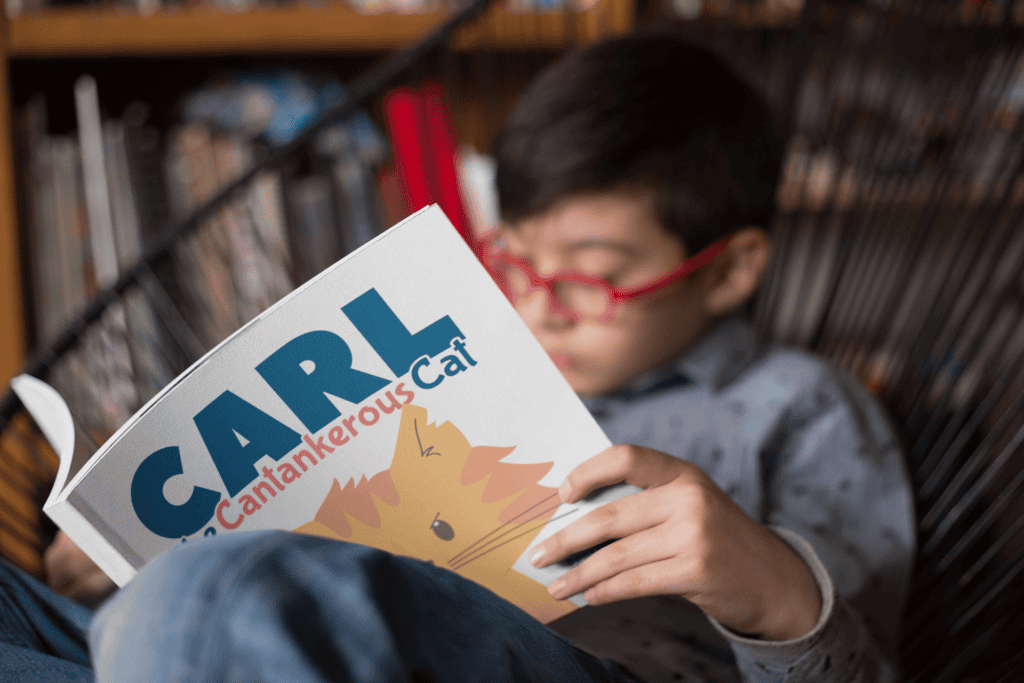
We purposely included words that are a bit beyond the readers’ current knowledge level, stretching their vocabulary. This deliberate choice draws from my experience in the Montessori classroom, where I used this strategy to challenge students beyond their existing knowledge base, fostering a sense of capability and encouraging them to expand their vocabulary.
This vocabulary-boosting picture book also includes words that children may already be familiar with but are presented in new contexts. By encountering these words in different settings, children can easily incorporate them into their everyday vocabulary, further enriching their language skills.
With the context provided by the story, the accompanying imagery, and the glossary, kids are able to grasp new word meanings.
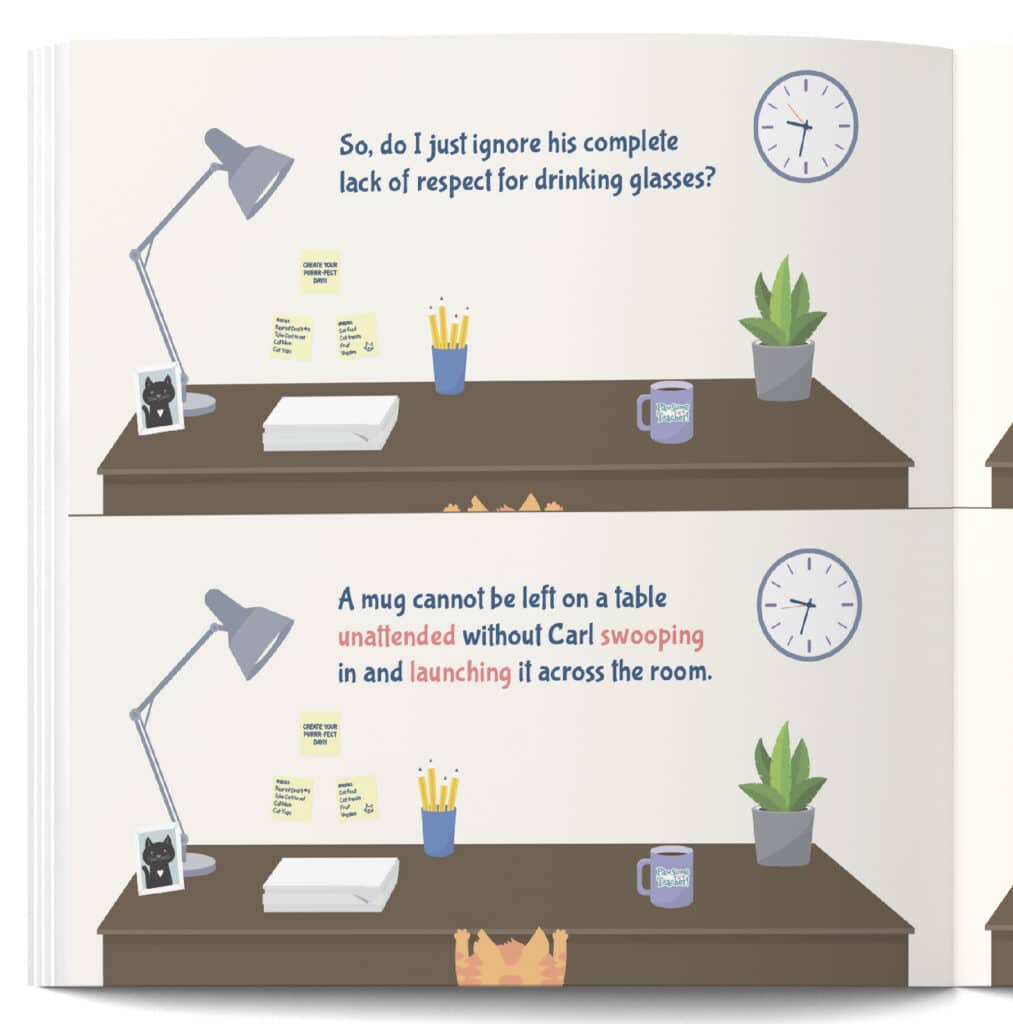
More Words For More Practice
A top-notch vocabulary-teaching book should offer a rich selection of words for children to explore.
The more extensive the word bank, the better, as it allows young readers to encounter a diverse range of vocabulary.
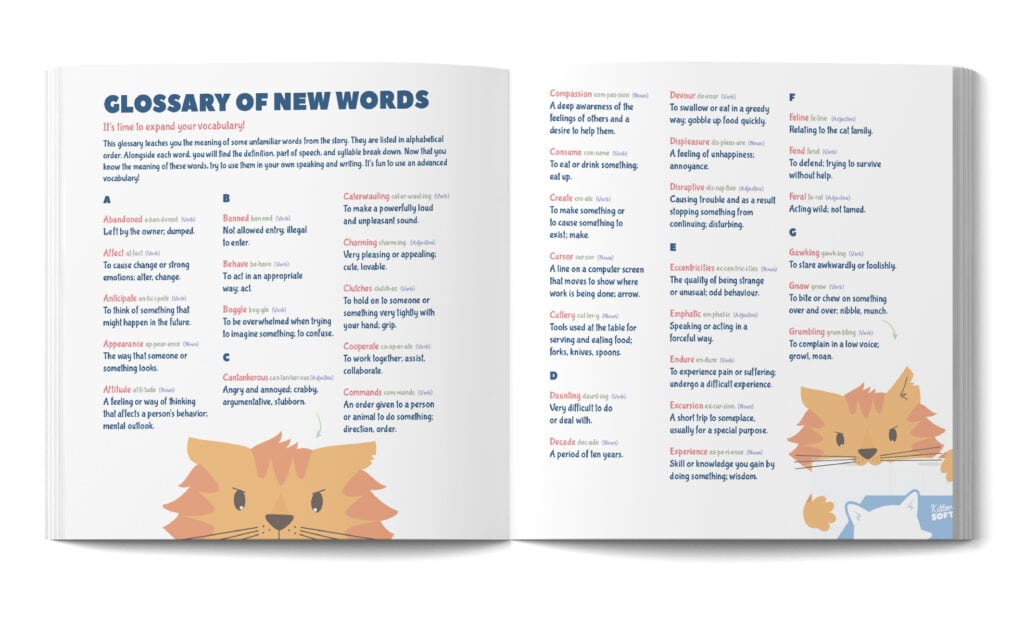
Having more words in the book adds more value too because it creates more opportunities for learning and understanding new vocabulary. Even if some words are challenging, they make the story more interesting and help kids improve their vocabulary skills.
Our book is one of the best picture books to teach vocabulary because of its wide word variety.
Our picture book doesn’t hold back on words. We believe the more, the better – and that’s why we’ve included over 70 advanced words and more than 30 pages in our picture book.
Throughout the pages of Carl the Cantankerous Cat, you’ll encounter a diverse array of words ranging from “charming” and “provoking,” to more challenging words like “serene” and “voracious.” This is just a glimpse of the extensive vocabulary found within the pages of this vocabulary-boosting book.
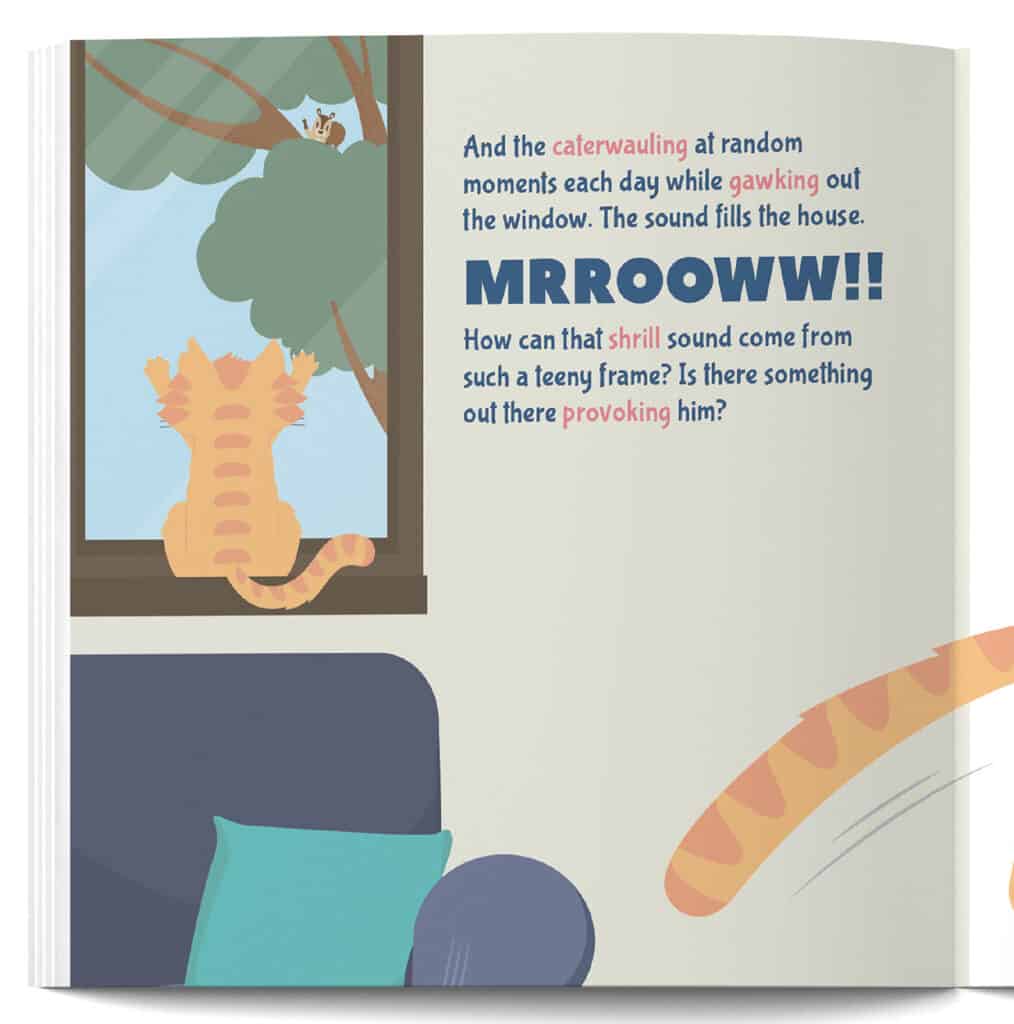
This diverse selection caters to all levels of learners, from beginners to advanced, ensuring every child finds words to expand their understanding.
The surplus of words in Carl the Cantankerous Cat broadens children’s vocabulary and also fosters their curiosity and engagement, inspiring them to explore new terms and meanings within and outside of the story’s context.
Guides Word Comprehension
The real magic unfolds when readers not only understand the meanings of words but also effortlessly incorporate them into their own stories.
One effective way to ensure comprehension is by providing word definitions.
That’s right!
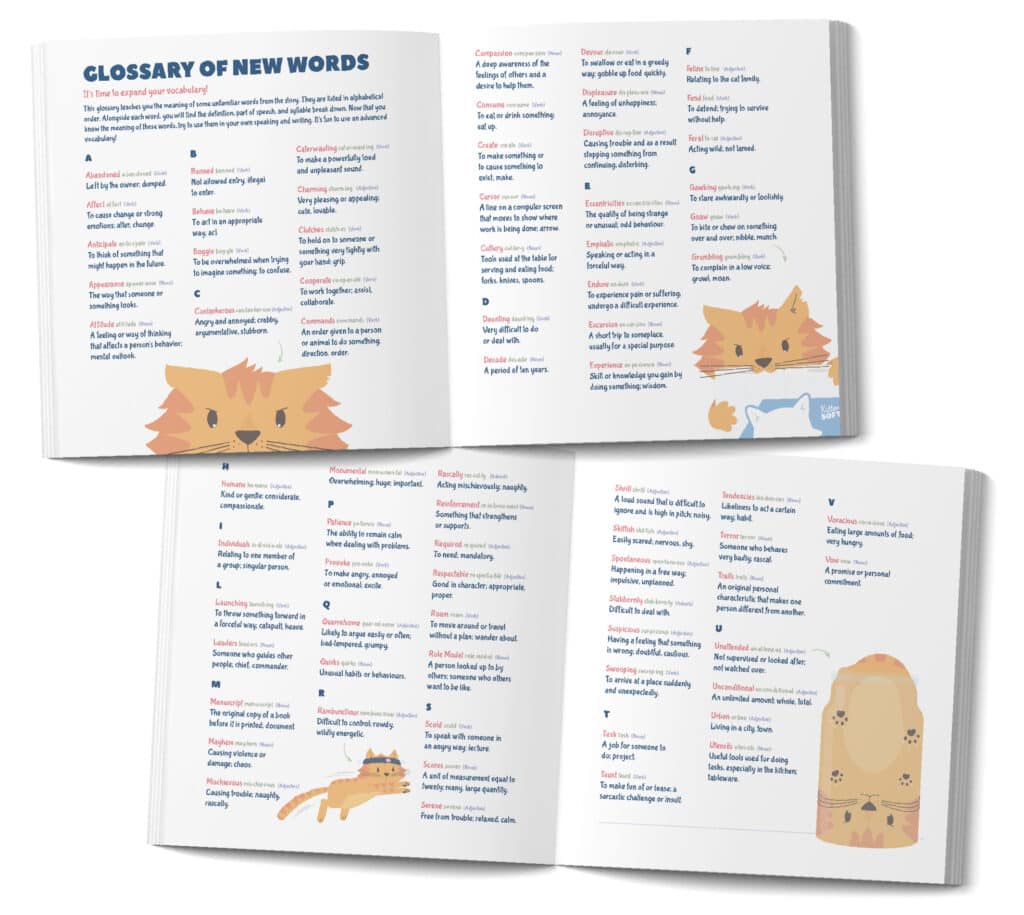
A standout vocabulary-teaching book does more than just introduce advanced words; it provides clear explanations of their meanings in a glossary or similar reference section.
Our book is one of the best picture books to teach vocabulary because it provides word definitions.
As a Montessori teacher, I know having a glossary in a vocabulary book can make a big difference. It helps readers understand new words better and makes every page exciting to explore. That’s why I made sure to include one in this book.
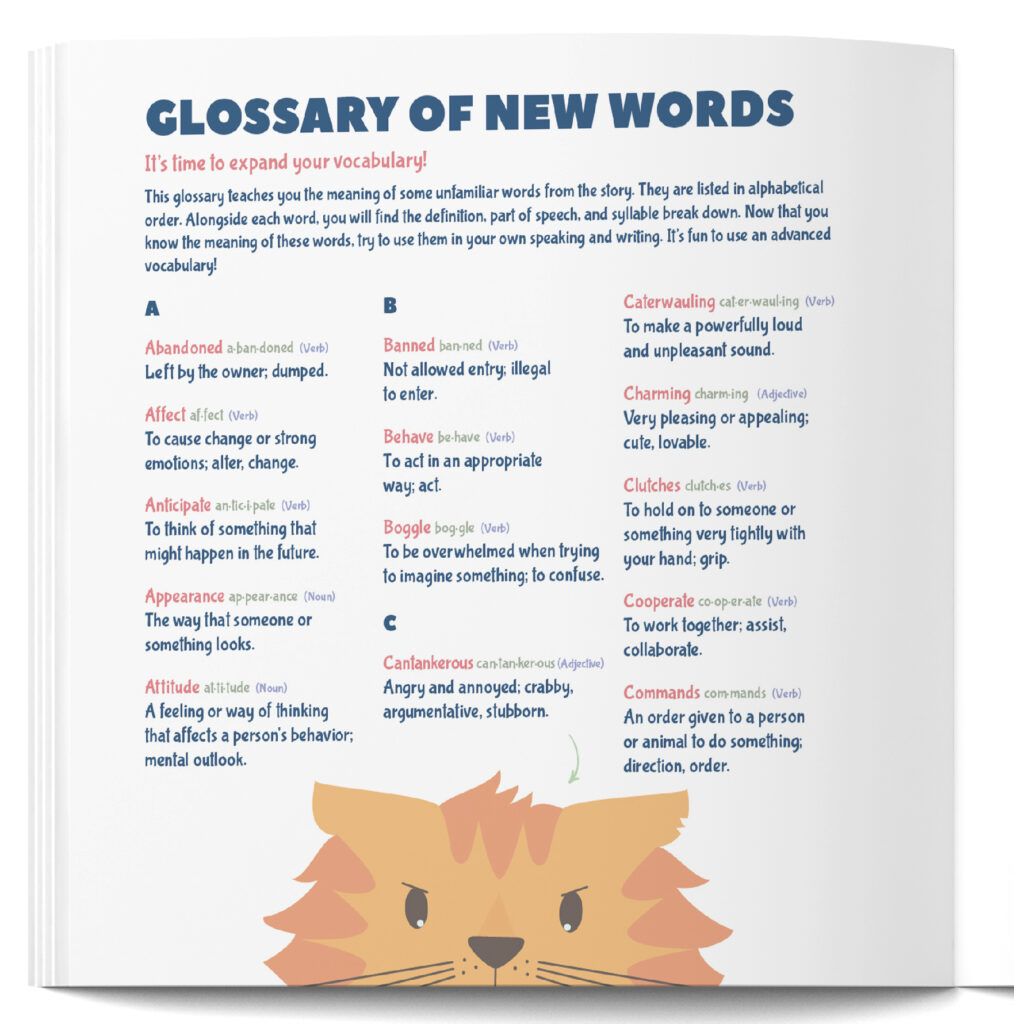
This added layer of comprehension ensures that children not only encounter new words but also understand how to use them appropriately.
Our glossary not only includes the word, but also their part of speech, syllable breakdown, as well as a kid-friendly definition.
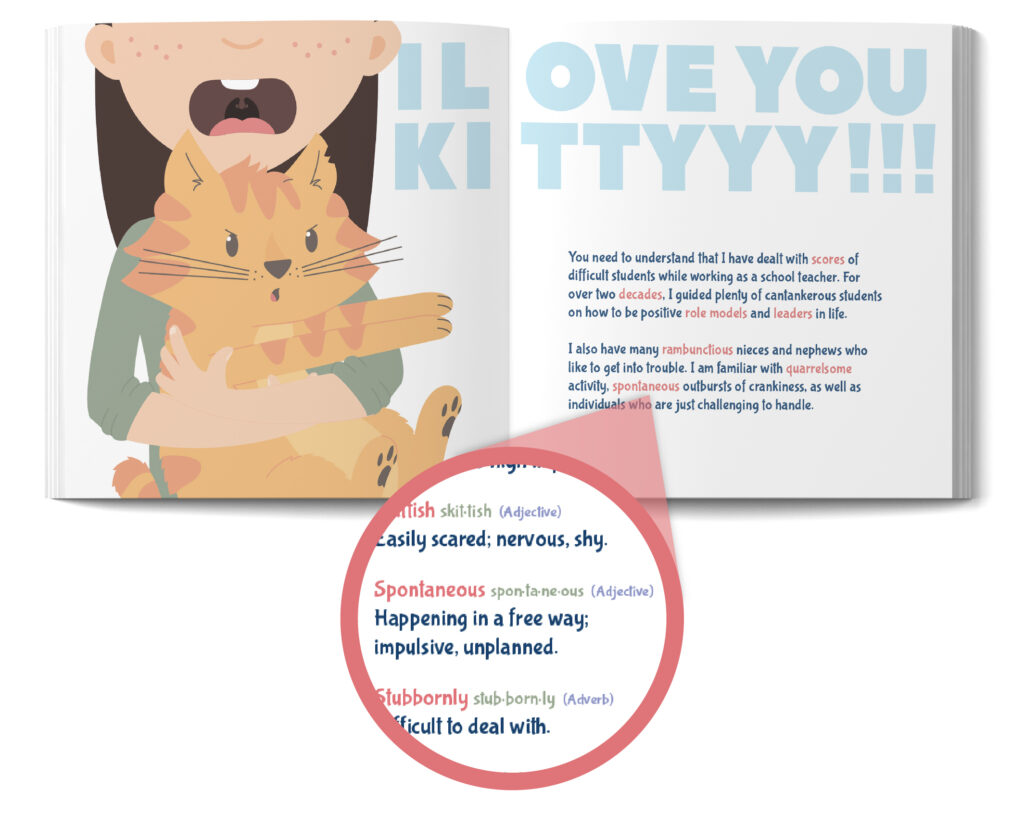
This feature mirrors Montessori principles by empowering readers to independently explore word meanings. By engaging with the glossary, children not only improve their dictionary skills but also strengthen their understanding of alphabetical order.
Makes Learning Words Fun and Memorable
When words are part of an engaging story, children understand them better and learn how to use them correctly.
A captivating storyline draws in the reader, making learning new vocabulary fun and easy to remember.
That’s certainly the case with Carl, our endearing yet slightly crabby protagonist.
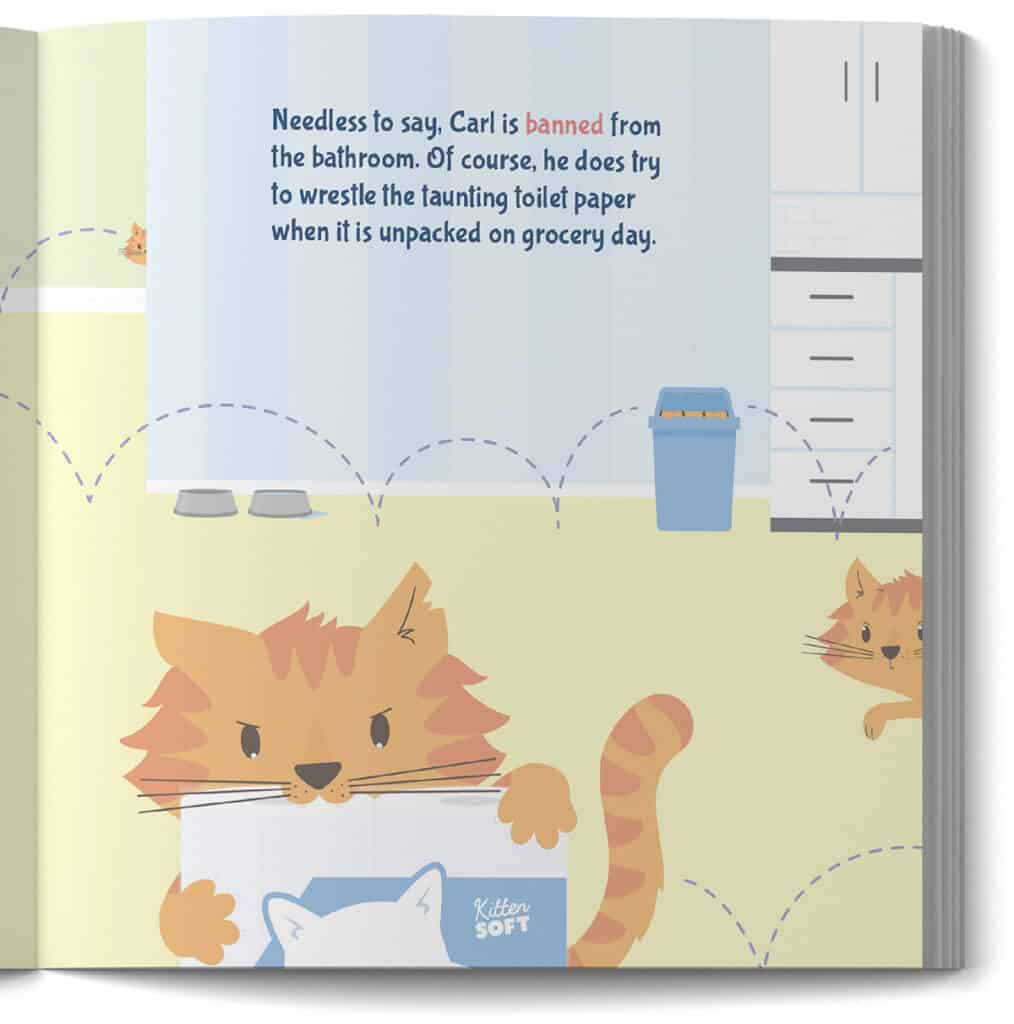
Our book is one of the best picture books to teach vocabulary because it’s fun to read.
As children follow Carl’s journey of learning to love and be loved, they are drawn into the story, instantly engaging with the character’s endearing yet cantankerous personality. Because the read is so enjoyable, kids easily soak up new words and remember them for everyday conversations.
Carl’s tale makes learning and using new words both enjoyable and unforgettable, leaving a lasting impact on readers’ vocabulary.
Engaging Illustrations That Boost Understanding
A picture is worth a thousand words, and they often tell stories in ways words can’t.
With the help of vibrant visuals, learning becomes an exciting journey where words are less intimidating. The beauty of picture book images is that they help readers retain new words with much less resistance. They ensure that learning remains engaging and entertaining.
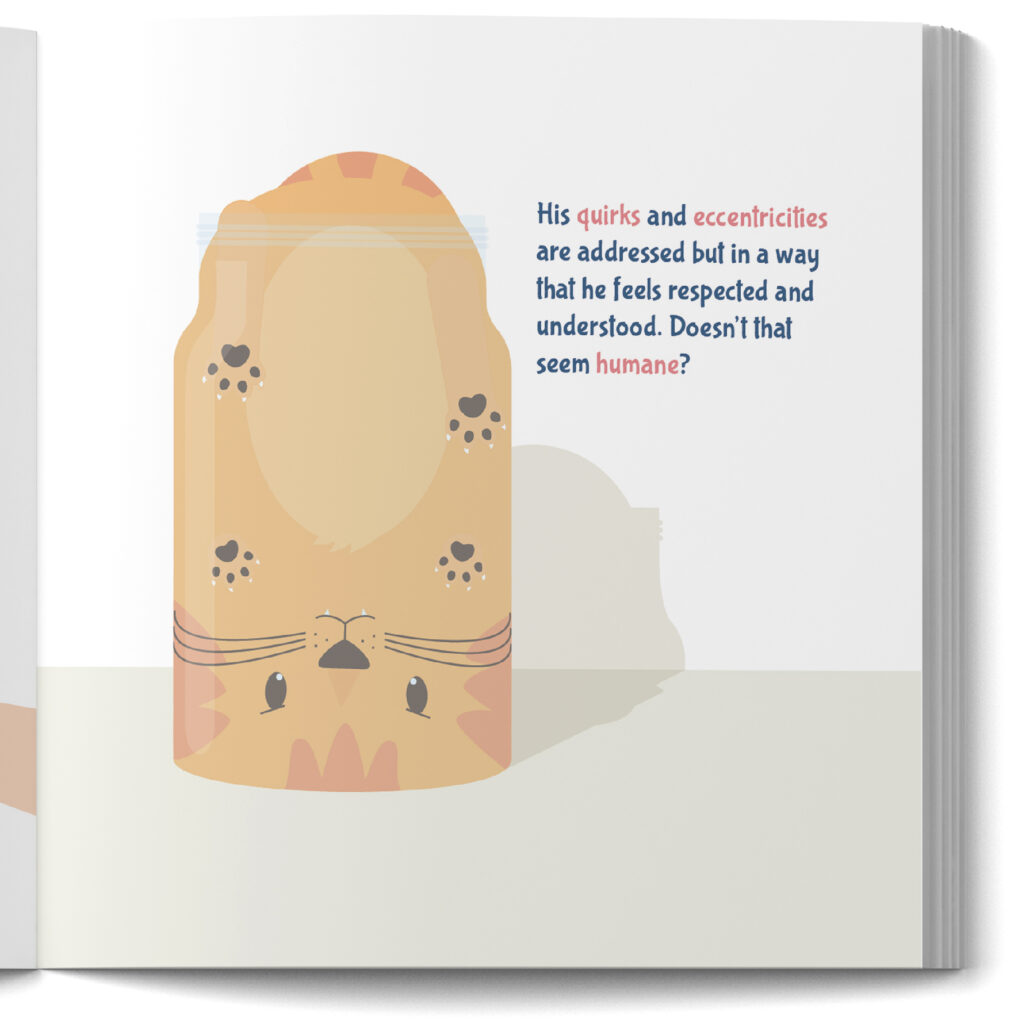
Our book is one of the best picture books to teach vocabulary because the illustrations are amazing.
By connecting words to images, readers can better grasp their meanings, even making educated guesses based on context. For instance, Carl’s crabby facial expression perfectly embodies the word “cantankerous,” adding depth and clarity to the learning process.
Picture books are invaluable assets in teaching vocabulary, and Carl the Cantankerous Cat stands out with its vibrant, detailed illustrations. The colourful, realistic yet cartoon drawings offer readers a deeper look into the story, transforming each page into a vivid exploration of language and imagery.
Promotes Repeated Readings for Deeper Understanding
For kids, a book that encourages repeated readings means jumping back into the story’s world, discovering new details, and understanding the story on a deeper level.
With each subsequent reading, readers become more familiar with the narrative, characters, and language, reinforcing comprehension and enjoyment.
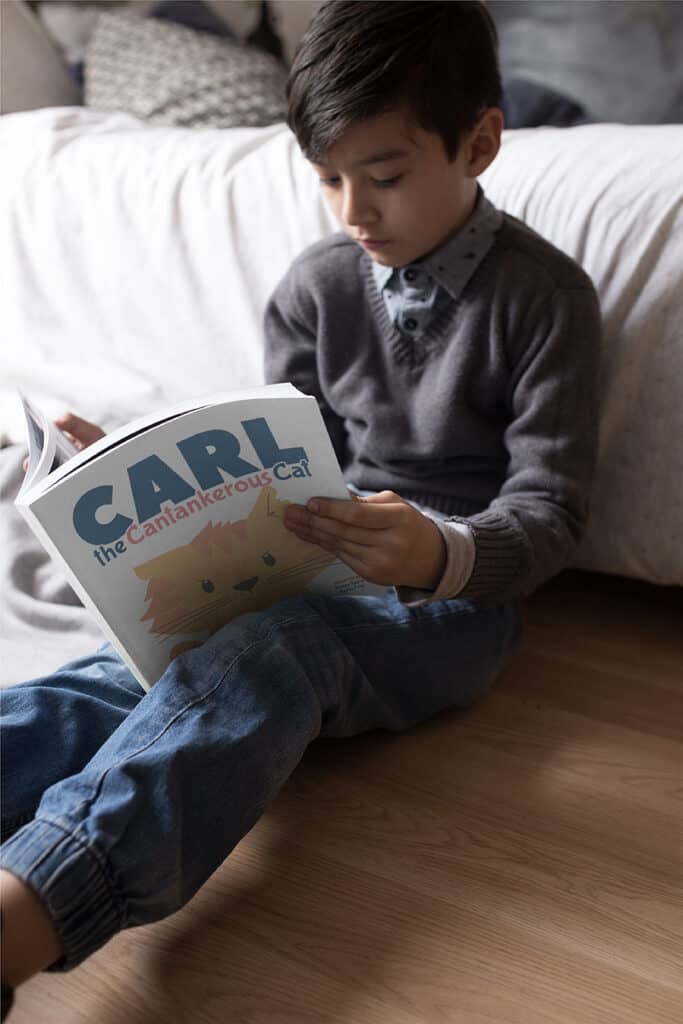
Our book is one of the best picture books to teach vocabulary because kids want to read it over and over again.
In Carl the Cantankerous Cat, there’s always something new to discover with each reading. Kids will uncover more about Carl’s behaviours, understand the story better, and effortlessly pick up new words along the way.
The colourful illustrations in a picture book don’t just add to the fun – they’re also packed with details that keep kids coming back for more.
Take, for example, this page from Carl the Cantankerous Cat:
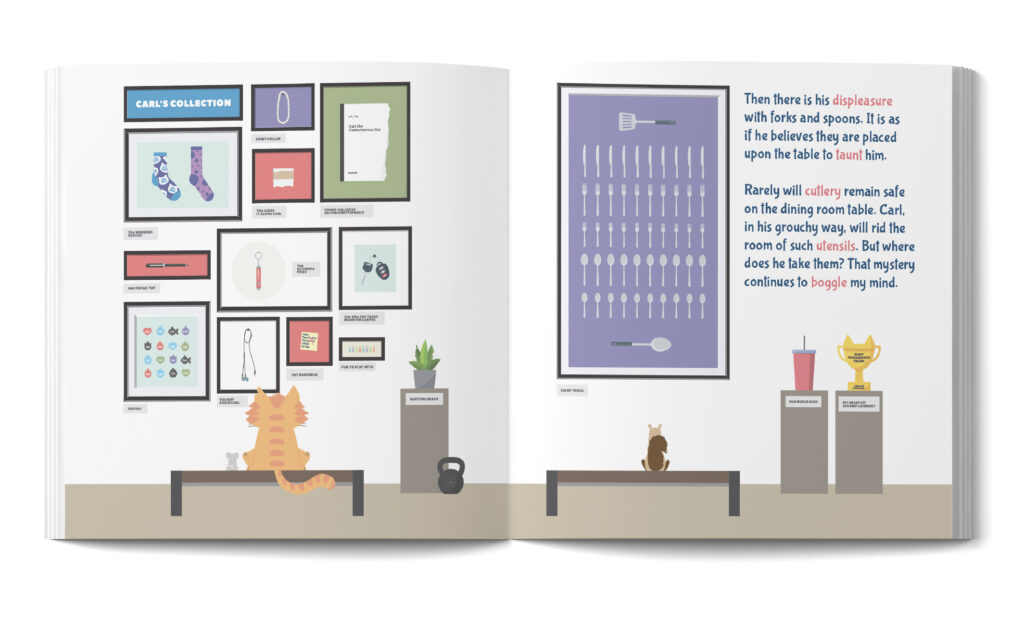
With every read, children will notice new details and pick up on funny, typical Carl behaviours, like his playful antics with cutlery.
The detailed illustrations make reading enjoyable and keep children engaged, encouraging them to come back to Carl’s story again and again.
Engaging Post-Reading Follow-Up Activities
A great picture book that builds vocabulary offers an opportunity for kids to keep learning after reading with engaging reading activities related to the book.
Post-reading activities align with the Montessori philosophy of education, which emphasizes hands-on, experiential learning and encourages children to explore and discover at their own pace.

By providing opportunities for children to interact with the story in meaningful ways beyond simply reading the text, these activities foster a deeper connection to the material and promote a holistic approach to learning.
Our book is one of the best picture books to teach vocabulary because it provides follow-up activities.
Carl the Cantankerous Cat goes above and beyond to satisfy this criterion. At the end of the book, there is a full-page spread of activities to continue learning after finishing the story.
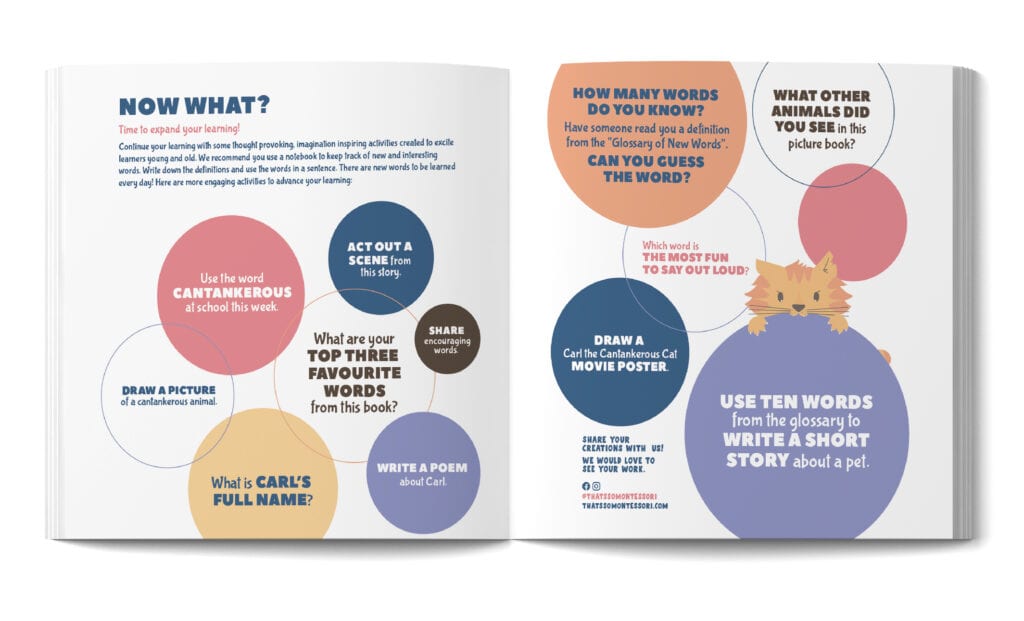
Additionally, we created a Carl the Cantankerous Cat activity pack, providing children with even more opportunities to explore vocabulary and concepts introduced in the story through puzzles, colouring pages, and more.
Follow-up activities empower kids in their learning journey post-reading.
😼 BONUS: Get a FREE page from Carl’s activity book now!
Spark learning fun with a free page from our Carl the Cantankerous Cat Activity Pack.
Encourage your kids to get creative with this cat-themed Mad Libs! They’ll explore different parts of speech while laughing their tails off. Subscribe to our newsletter to receive this printable directly to your inbox for some purr-fect fun!
😸 Get the whole activity pack!
Immerse your students in a PURRfectly crafted digital picture book and printable activity pack that will leave them grinning from whisker to whisker as they soak up knowledge. With over 70 sophisticated vocabulary terms cleverly introduced in this engaging eBook, learning never felt this enjoyable!
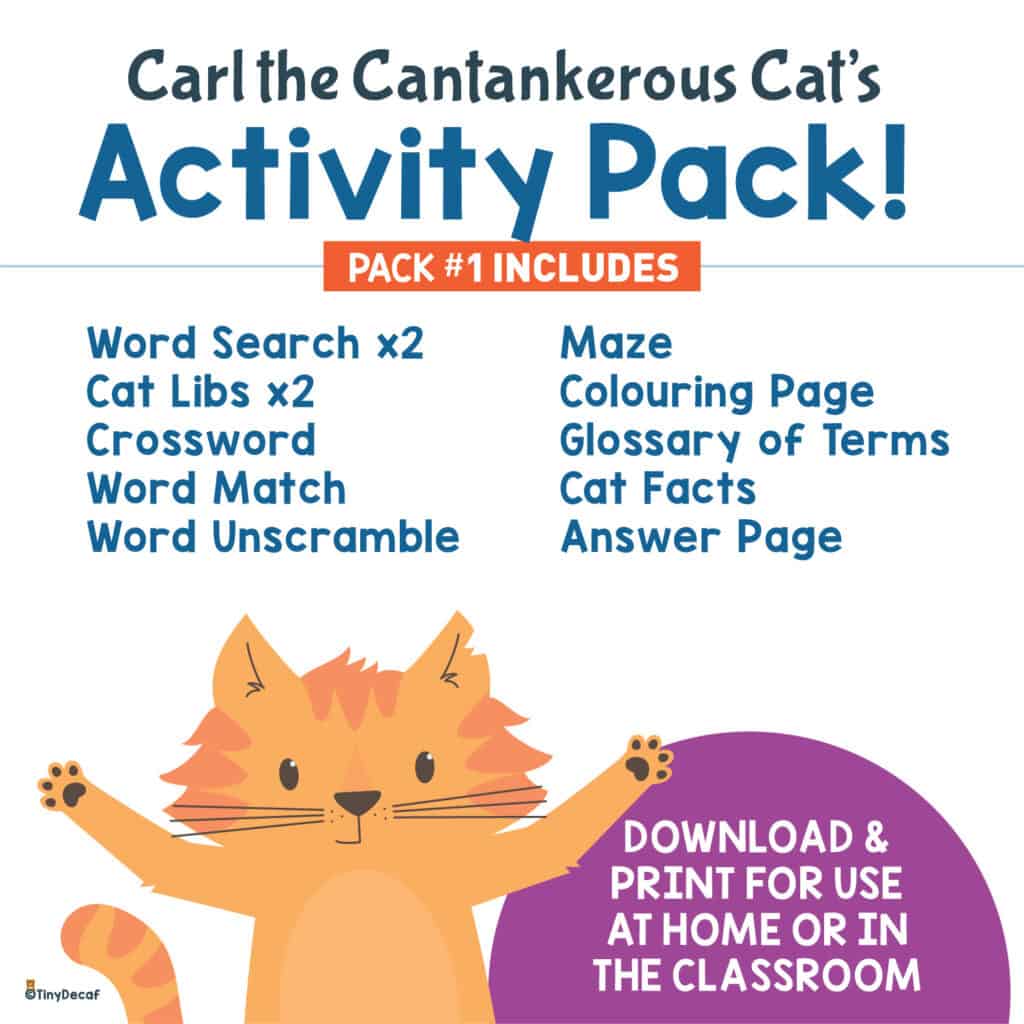
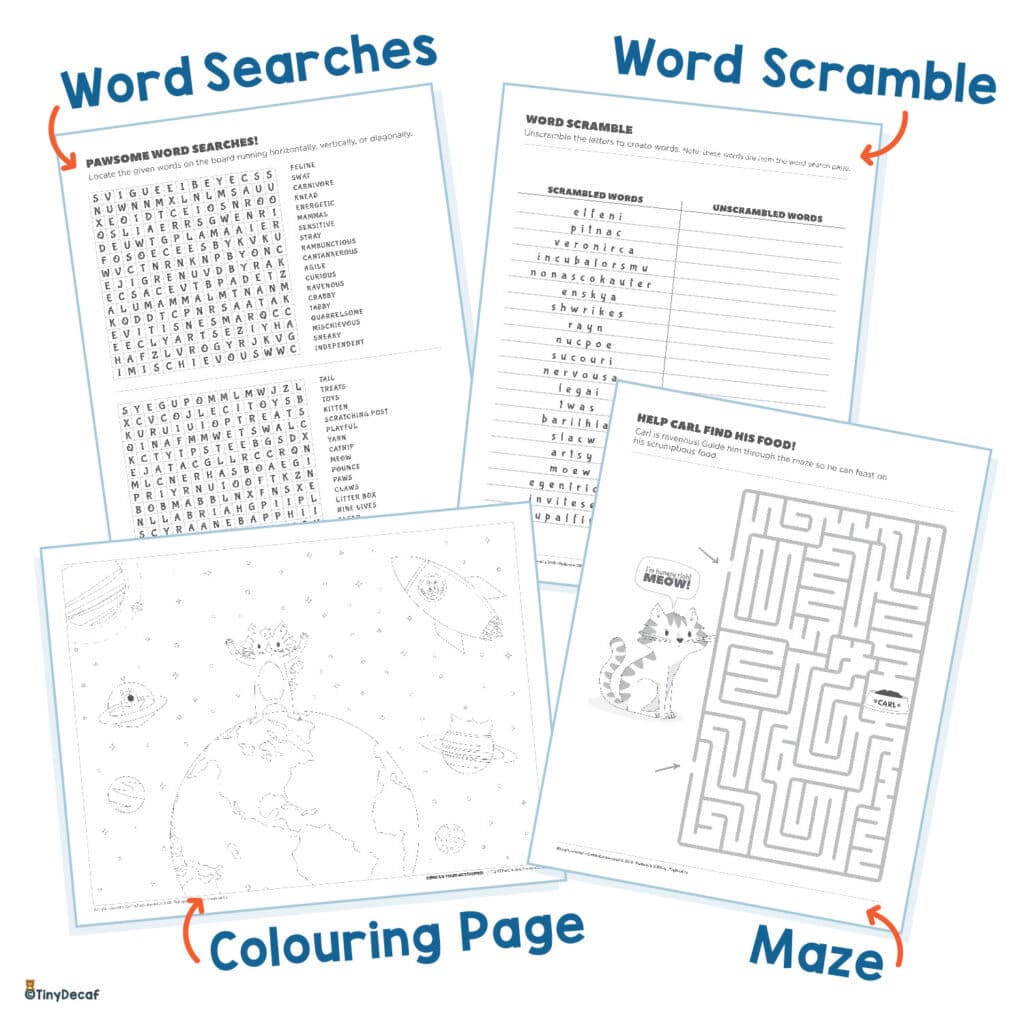
With an eBook boasting over 30 pages of captivating illustrations and 70+ sophisticated vocabulary terms, plus a 16-page printable Activity Pack packed with word searches, crossword puzzles, Cat-libs, word matching, word scramble games, and even acrostic poems, this educational entertainment is the cat’s pajamas!
Glowing Customer Reviews
Customer reviews gauge picture book effectiveness in teaching vocabulary, especially with diverse word usage. Readers often share how the book captivates young readers and helps them learn new words.
Positive reviews highlight the book’s impact on children’s language skills. Parents frequently mention how their kids learn and understand more words after reading, proving it’s a helpful tool for learning.
Our book is one of the best picture books to teach vocabulary because it has great reviews.
Reviews for Carl the Cantankerous Cat often praise its ability to introduce new words and enhance vocabulary in young readers. Parents appreciate its word integration, aiding their children’s learning.
In short, positive customer reviews will help you understand how well a picture book teaches new words.
More Vocabulary Teaching Picture Books
Looking for more vocabulary-enriching picture books for elementary students?
Here are a few picture books I consider among the best to teach vocabulary:
These books not only introduce new words but also engage children with captivating stories and delightful illustrations, making language learning an enjoyable experience.

💡 Find more great books for the elementary level here:
31 Picture Books for 5th Graders with Expert Tips for Selection
35 Money Books for Kids that Teach Financial Literacy
25 Best Picture Books with Rich Vocabulary
⬇️ And check out these ideas for upper elementary book reports:
Book Report Ideas for 5th Grade that Spark Imagination
The Wrap-Up: One of the Best Picture Books to Teach Vocabulary
You heard it here first: Carl the Cantankerous Cat reigns supreme as one of the best picture books to teach vocabulary at the elementary level!
With its captivating storyline, charming main character, advanced vocabulary, and interactive activities included, Carl makes learning words a memorable adventure.
Consider this your cue to include Carl the Cantankerous Cat and other exceptional picture books that focus on vocabulary enrichment to your bookshelf. Witness the magic as your child’s vocabulary takes flight!
Keep your kids learning with the educational activities in these blogs:
11 Ways to Use Our Roll A Story Dice Game
Parts of Speech Videos for Your Elementary Language Lessons
13 Engaging Vocabulary Development Activities for Elementary Kids
Book Report Ideas for 5th Grade that Spark Imagination
Rebus Puzzles for Kids: A Comprehensive Riddle-Solving Guide
57 Epic Montessori-Aligned Spring Break Activities for Your Kids
31 Fun Summer Reading Activities Elementary Students Will Love
The Best Neighborhood Walk Scavenger Hunt
8 Easy Rebus Puzzles with Answers
27 Educational YouTube Channels to Prevent Summer Learning Loss



